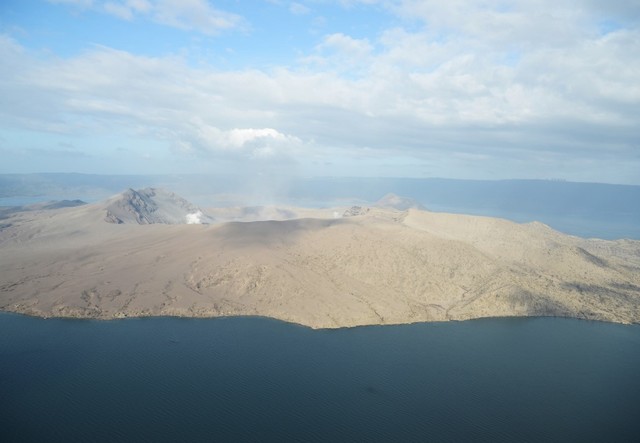
White steam is emitted from Taal Volcano as seen from a Philippine Air Force helicopter
MANILA, Feb 14 (NNN-Xinhua) — Philippines volcanologists on Friday further lowered the alert level to 2 at Taal Volcano, nearly five weeks since it began spewing ash and steam.
In its latest bulletin, the Philippine Institute of Volcanology and Seismology said the condition in the volcano in Batangas province, about 66 km south of Manila, “in the succeeding three weeks has been characterized by less frequent volcanic earthquake activity, stabilizing ground deformation of the Taal Caldera and Taal Volcano Island edifices and weak steam or gas emissions at the main crater.”
Taal volcano erupted on Jan 12, prompting the institute to raise the alert level to 4 on a scale of 5. Level 4 indicates the eruption could occur within days, and level 5 means a hazardous eruption is in progress.
The institute reminded the public that at alert level 2 means that sudden steam-driven or phreatic explosions, volcanic earthquakes, ash-fall and lethal accumulations or expulsions of volcanic gas can occur and threaten areas within the Taal Volcano island and along its coast.
The institute also recommended that entry into the island and Taal’s permanent danger zone is strictly prohibited.
The eruption displaced nearly 380,000 villagers and destroyed many farms, houses and roads in the province. It also affected the tourism industry in the province. Taal Volcano is a popular tourist destination because of its picturesque setting in the middle of a placid lake.
No people were killed in the eruption; only animals. Scores of horses and farm animals left behind by villagers that fled the volcano island were buried under the dense ash after the Jan. 12 eruption. Dozens of birds also died from the clouds of ash emitted by the volcano, home to more than 50 bird species.
However, the tourism industry in the affected areas, particularly in Tagaytay City, has suffered a tremendous setback.
The volcanic ash also blanketed farms planted to pineapple and banana. The damage to agriculture is estimated at 3 billion pesos (about 59 million U.S. dollars).
At an active earthquake zone, the Philippines has frequent seismic activity due to its location along the Pacific “Ring of Fire.” — NNN-XINHUA
